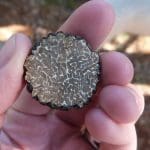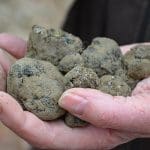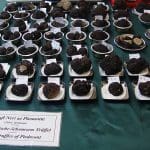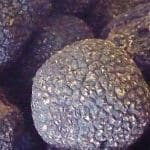Black Truffle / Spring / Winter / Edible
Prepare to enter a world of unparalleled gastronomic indulgence as we unravel the secrets of the Black Truffle, scientifically known as Tuber melanosporum.
In this blog post, we embark on an extraordinary journey into the realm of culinary opulence, where the unmistakable aroma and exquisite flavors of this prized fungus reign supreme. Renowned as the “Diamond of the Kitchen,” the Black Truffle captivates the palates of epicureans and chefs worldwide, adding a touch of decadence to dishes fit for royalty. Join us as we delve into the rich history, unique cultivation methods, and unparalleled culinary applications of this coveted delicacy. From truffle-infused risottos to luxurious sauces, the Black Truffle promises to elevate your dining experience to unparalleled heights. Let us unlock the secrets of Tuber melanosporum, where culinary luxury meets unparalleled sensory bliss, and immerse ourselves in the allure of this revered treasure trove of flavors.
Scientific Name
Tuber melanosporum
Common Names
Black Truffle, Périgord truffle, French Black truffle
Family
Tuberaceae
Habitat
They are mycorrhizal and grow just beneath the surface near oak, popular, beech and hazel trees. Unfortunately they aren’t found in the UK, they’re famously found in the Périgord region of France but are also native to Spain, Italy and Croatia. They are also being cultivated in Australia, New Zealand, Chile, North America, Argentina, South Africa and Wales.
Description
A delicious and much sought after fungus, they are one of the most expensive fungi in the world, second only to the White truffle (Tuber magnatum).
Identifying Features:
Cap:
The roughly ball shaped, fruit bodies or ascocarps, can be up to 10cm in diameter. Their skin or peridium is dark brown in colour and is covered in a network a pyramid shaped ‘warts’. Giving the whole body a rough bark-like texture. They lack a stem or gills, their spores are produced inside and are spread when animals eat and later deposit them. They are normally harvested between December and March.
Smell:
A nutty/mushroom type smell. Some say strawberries and cocoa.
Spores:
Black to brown.
Uses
In food
They are much prized by chefs and have a lovely hazel nutty, fungal flavour. Unlike White truffles, the flavour of Black truffles gets more intense when heated.
As they are quite expensive, a good way to make the most of them is to store the truffle in a basket full of eggs. As the eggs shells are permeable the truffle flavour will transfer and makes the most amazing scrambled eggs.
After that they can be finely sliced or grated over savoury dishes or infused in oil to add a heady umami kick.
Notes on Herbal Uses
Truffles are general contain many important vitamins and nutrients including vitamin C, phosphorus, sodium, calcium, magnesium, manganese and iron.
They contain lycopene, gallic acid and homogentisic acid, which are important amino acids that studies show may lower your risk of conditions such as such as cancer, heart disease and diabetes.
They are also said to have aphrodisiac properties and have been used to boost fertile.
Known hazards
None known.
Potential lookalikes
I specialise in wild plants and fungi of the UK and I have never had the opportunity to go truffle hunting abroad. There aren’t too many lookalikes that I’m aware of but I would certainly want to be guided by a local expert.
But if you are buying Black truffles beware of the very similar Chinese truffle (Tuber indicum). It’s a lot less flavoursome and much cheaper but some do try to pass them off as true White truffles. To avoid fraud or misidentifications in business, a genetic test has been developed to distinguish the two species. You can check them yourself, the skin of the Chinese truffle is smoother and dark red or dark brown.
Extra Notes from the Foragers
Although not native to the UK, they have been successfully cultivated in Wales. The first truffle from an inoculated tree was harvested in 2017. These results suggest that they could be grown in many areas of the country. Who knows it could open up a whole new way of protecting and establishing new woodlands. The truffle industry is projected to be worth £4.5 billion annually in the next 10-20 years.
References:
https://www.cam.ac.uk/research/news/perigord-black-truffle-cultivated-in-the-uk-for-the-first-time#:~:text=Researchers%20from%20the%20University%20of,species%20has%20ever%20been%20found.
https://www.bbcgoodfood.com/recipes/collection/truffle-recipeshttps://www.healthline.com/nutrition/truffleshttps://www.englishtruffles.co.uk/truffles-about/
https://www.bbcgoodfood.com/recipes/collection/truffle-recipeshttps://www.healthline.com/nutrition/truffleshttps://www.englishtruffles.co.uk/truffles-about/
https://www.bbcgoodfood.com/recipes/collection/truffle-recipeshttps://www.healthline.com/nutrition/truffleshttps://www.englishtruffles.co.uk/truffles-about/










Leave a Reply
You must be logged in to post a comment.